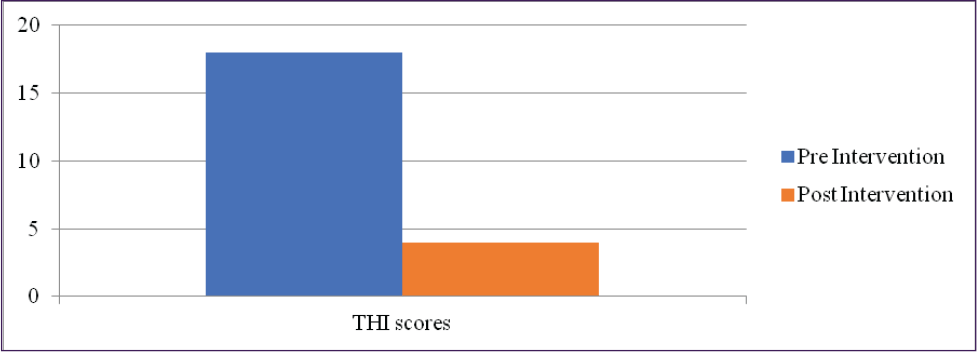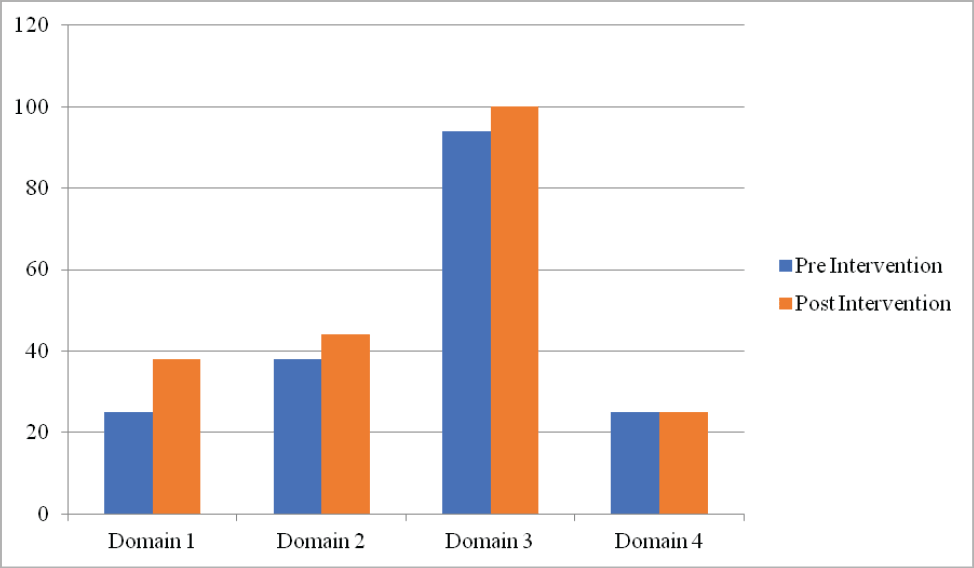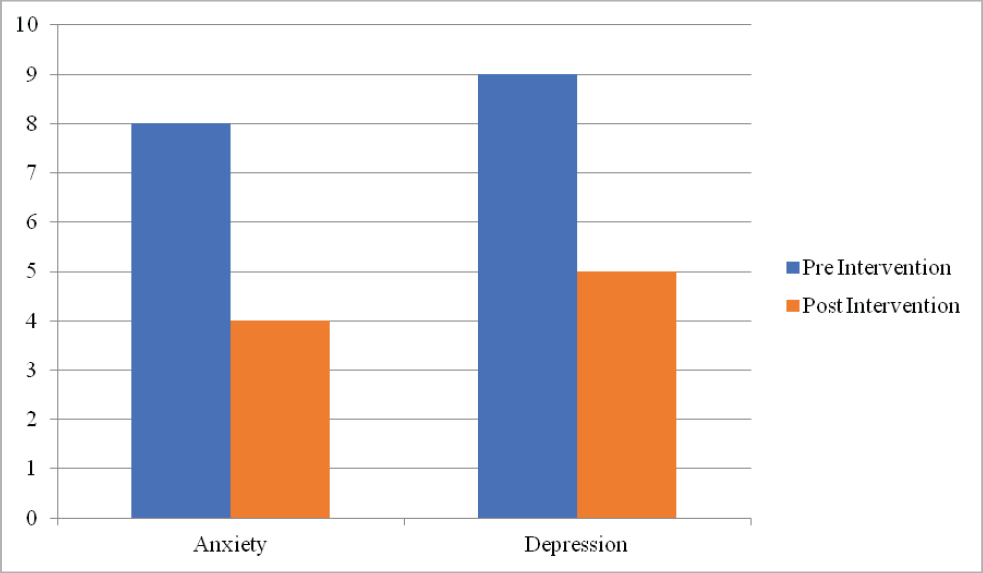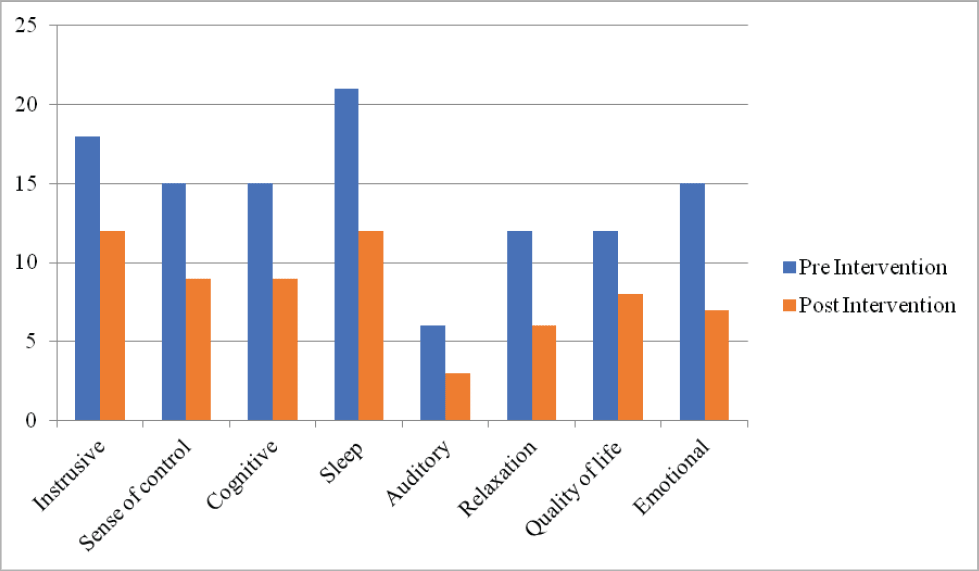
Integrative Medicine Case Reports, Volume 3, Issue 2 (July), 2022
Natural relief to tinnitus through Yoga: Is it a myth or reality? – a case report
KEY WORDS |
ABSTRACT |
|
Tinnitus
|
Tinnitus individuals often report psychological problem like anger, depression, low confidence etc. Due to Lack of any well-structured approach for the tinnitus treatment, many approaches have been utilized in the past to reduce the psychological issues in tinnitus suffers. However, the effectiveness of the Yoga in this context is not well studied. Therefore, in the present case efficacy of the Yoga is studied in reducing the tinnitus related psychological problems. Tinnitus retraining therapy and Yoga was introduced for the six months. Tinnitus handicap, Quality of life, depression and anxiety were assessed before and after the treatment. Patient’s post therapy scores of on all measures i.e., Tinnitus handicap inventory, hospital anxiety and depression scale, WHO-BREF, tinnitus functional index were reduced as compared to scores at the time of the initial assessment. Yoga is an effective treatment option in reducing the handicap, depression and anxiety in tinnitus patient. This further can leads to the improvement in quality of life of tinnitus sufferer.
doi: 10.38205/imcr.030265 |
|
*Corresponding Author:
|
Introduction
Tinnitus is the term used to describe a condition in which a person hears a sound, yet there are no sounds in their surroundings that correspond to that sound. Tinnitus prevalence has been estimated to range between 10 and 15 percent based on data acquired from epidemiologic studies conducted in various countries. Tinnitus is usually associated with symptoms such as depression, anxiety, restlessness, sleep disturbances, inadequate rest, attention problems, and auditory hyperalgesia (1).
It is crucial to emphasize the connection between tinnitus, the limbic system, and prefrontal brain activity. When tinnitus is severe, depression, anxiety, and other psychiatric diseases may be associated with it since this area of the brain is connected to emotions. Tinnitus is also accompanied by autonomic dysfunctions, and the limbic response to the sound often reinforces negative feelings toward the sound (2). Patients express poor quality of life, irritability, despair, and insomnia, and these states may change according on the severity and frequency of this condition.
Numerous methods have been used to manage tinnitus, including electromagnetic stimulation, acupuncture, cognitive behavioral therapy, sound therapy, tinnitus retraining therapy, biofeedback, and sound therapy (3). These treatments have variable effects on patients because there are numerous tinnitus aetiologies.
Growing evidence and research show that Yoga can improve both physical and mental wellness (4). Yoga is a holistic method of promoting health and wellness that places a focus on mental processes. It incorporates various mindfulness exercises, breathing exercises, physical postures and movements, relaxation techniques, and meditation (5).
Yoga promotes better sleep, improved overall health and quality of life, stronger and more flexible muscles, better respiratory and cardiovascular function, and a decrease in stress, depression, and anxiety (6,7). According to recent studies, practicing Yoga considerably reduced irritability, life stress, depression, and subjective tinnitus symptoms (8). Additionally, when the patient grows accustomed to the noises and their emotional and physical well-being improves, tinnitus may become less obtrusive and bothersome (9,10).
However, there are few national and international studies examining the effectiveness of Yoga for individuals with tinnitus. The current case study aims to close this knowledge gap by citing evidence of Yoga’s ability to lessen tinnitus symptoms.
Case presentation
A 54-year-old Asian man from northern India visited the otolaryngology department complaining of continuous noise in both ears for the preceding six months. His sociodemographic data revealed that he was self-employed, from an urban joint family, and had a postgraduate degree. According to patient, his problem manifested suddenly, without any apparent reason or event. The patient stated that it the sound is continuous and resembles the sound of popping of water. His tinnitus-related personal symptoms showed that he had trouble falling asleep. Additionally, he observed that environmental noises could mask his tinnitus. When he was trying to fall asleep, he was most aware of his tinnitus, and when he was working, he was least aware. No complaint of hearing loss, speech perception, balance issues, hypercusis, misphonia, headaches or any other kind of body pain were reported by the patient. There was no significant medical and psychological disorder history like ear infection, diabetes, head trauma, hypertension, depression, loud noise exposure or any other disease which is associated with tinnitus. No family or genetic history of hearing loss was present. No treatment or intervention for tinnitus have been taken by patient in the past.
Procedure
Physical and otoscopic examination shows structurally normal pinna, external ear canal, tympanic membrane and post auricular region. Following the otoscopic examination, the patient underwent a full battery of audiological tests. To evaluate the hearing sensitivity and integrity of the auditory pathways, pure tone audiometry (PTA), immittance audiometry (IA), Reflexometry, Otoacoustic emission (OAEs), Auditory brainstem response (ABR) were carried out. The psychoacoustic components of tinnitus were assessed using the loudness and pitch matching of the tinnitus. The matching was done with the subject’s contralateral ear when they had tinnitus in one ear. Tinnitus matching was carried out contralateral to the one with the worst tinnitus if there was tinnitus in both ears. The level of distress was assessed using the Tinnitus Handicap Inventory. Tinnitus patients were given the Hindi translation of the THI’s English version, and overall scores were calculated. Responses from subjects were scored on a scale of yes, no, or sometimes. “Yes” answers received a score of 4, “some-time” received a score of 2, and “no” received a score of 0. After that, the subject was categorized into one of the following five categories: catastrophic, slight, mild, and Moderate. Additionally, the Tinnitus Functional Index (TFI) was used to assess the effect of eight different tinnitus-related annoyances on the patient’s life, including intrusiveness, feeling of control, cognition, sleep, hearing, relaxation, quality of life, and emotional impact. Overall quality of life was assessed using the WHOQOL-BREF questionnaire. To assess the patient’s psychological health, the anxiety and depression scale was also used.
Intervention program
For tinnitus management, Tinnitus retraining therapy and Yoga were introduced to the patient. Tinnitus retraining therapy was done by a licensed audiologist with experience in patient’s counselling for psychological issues associated with tinnitus and use of tinnitus maskers. The subject got input on the tinnitus generation and his misconceptions about the condition were also clarified. After that, Yoga therapy was also introduced to reduce the psychological problems due to tinnitus.
Yoga therapy (6 months)
To reduce the tinnitus related psychological issues like stress, anger Yoga was introduced. For 24 weeks, one 60-minute Yoga practice every day was scheduled. A trained Yoga instructor led the final Yoga session. Every class started with a 15-minute warm-up, then consisted of poses for 30 minutes, breathing exercises for 15 minutes, and meditation for the final 5 minutes. As part of the warm-up activities, the subject coordinated his breathing and stretched entire body before repeating the Yoga poses. There are several Yoga poses, including MAKARASANA (The Crocodile Posture), BHUJANGASANA (The Cobra Posture), Sarala Bhujangasana, UTTANA PADASANA (The Raised Feet Posture), Kapalabhati Yoga, and Anuloma Pranayama. During the meditation, subject sat in a secure and comfortable position with their eyes closed. The subject then performed the same exercises at home each day till the nest session and sent a video of that to the Yoga teacher for follow-up. In the present case, patient used a speaker as a bedside noisemaker to play music before getting to sleep.
The pure tone threshold average of the patient was 20dBHL, which indicates bilateral normal hearing in both ears. OAEs and Acoustic reflexes were present on both sides. The results of impedance audiometry revealed bilateral type A tympanograms in both ears with preserved middle ear muscle reflexes at all frequencies except at 4khz in right ear. During loudness and pitch assessment, for right ear pitch was matched at 9250 Hz frequency having loudness of 85dBHL. Similarly for the left ear pitch was matched at 10200Hz frequency having loudness of 70dBHL.
Tinnitus handicap inventory
The THI score of the patient before intervention and counselling was 18 which represent mild degree of annoyance due to tinnitus. THI score after Yoga intervention and tinnitus counselling was 4, which shows a remarkable reduction in the annoyance due to tinnitus (Figure 1).

Figure 1: Pre and post intervention Tinnitus handicap inventory (THI) scores of the patient
WHO-BREF
Quality of life assessment score before and after intervention was 5 and 5, respectively. Scores of each domain are given in the table (Table 1 & Figure 2).
Table 1: Patient’s pre and post treatment scores on THI, WHO-BREF, TFI and Hospital anxiety and depression scale
Sr. No. |
Test name |
Pre-Intervention score |
Post-Intervention score |
|---|---|---|---|
1 |
Tinnitus Handicap Inventory (THI) |
18 |
4 |
2 |
WHO-BREF |
||
a. Domain 1 |
25 |
38 |
|
b. Domain 2 |
38 |
44 |
|
c. Domain 3 |
94 |
100 |
|
d. Domain 4 |
25 |
25 |
|
3 |
Hospital Anxiety and Depression Scale |
||
a. Anxiety |
8 |
4 |
|
b. Depression |
9 |
5 |
|
4 |
Tinnitus Functional Index (TFI) |
45.6 |
26.4 |

Figure 2: WHO-BREF scores of various subdomains in pre and post intervention condition
Hospital anxiety and depression scale
It consists of two subdomains: Anxiety and Depression. For anxiety subdomain score before and after intervention was 8 and 4 respectively. Similarly, for depression subdomain score before and after intervention was 9 and 5 respectively (Figure 3).

Figure 3: Hospital Anxiety and Depression Scale scores of various subdomains in pre and post intervention condition
Tinnitus Functional Index (TFI)
The global TFI result before and after intervention showed that the level of tinnitus was 45.6 and 26.4, respectively (Figure 4).

Figure 4: Pre and post intervention Tinnitus Functional Index (TFI) scores of eight subscales in tinnitus patient
Discussion
PTA, OAE, Reflexometry, MLR, and LLR findings show that the patient’s hearing sensitivity was normal and that there was no retro-cochlear disease. Due to the fact that the true pathophysiology of the condition is unknown, symptomatic alleviation has been the main focus of tinnitus treatment. Studies have demonstrated the therapeutic benefits of Yoga in reducing stress symptoms such hypertension and sleeplessness as well as anxiety, depression, and sleep problems. Therefore, we anticipated that doing Yoga would help patient feel less anxious about the tinnitus (11). The results of Pre and post treatment scores of various tests is showed in table 1.
The fact that the THI and HADS scores were lower after the intervention clearly shows that a combined strategy of tinnitus counselling and Yoga therapy can assist in lowering the irritation and tension caused by tinnitus. The patient’s functionality in numerous facets of life has improved, according to the TFI questionnaire. After six months of therapy, the negative effects of tinnitus were lessened on all subscales that had been tested. Additionally, an improvement in WHO-BREF score following treatments also suggests that tinnitus patients’ quality of life has improved. The results demonstrate a notable improvement in the tinnitus patient’s everyday functioning.
Yoga teaches patients how to control their body, breathe deeply, and relax their muscles, all of which assist to lessen the stress brought on by tinnitus. As a result of all these advantages, Yoga is quite beneficial for patients. Previous research has also demonstrated that practicing Yoga reduces levels of sympathetic hormones, stimulates the limbic brain, and activates antagonistic neuromuscular systems (6). This ultimately results in calmness and tranquillity. Thus, doing Yoga regularly can improve mood and reduce mental tension, both of which are beneficial for people who suffer from tinnitus. The current study’s findings are consistent with past studies showing that Yoga can improve people’s general health and quality of life while also helping them properly manage their stress and anxiety. When executed effectively, these findings imply that Yoga might be regarded as a successful intervention program to lessen the anxiety and despair linked to tinnitus.
Conclusion
Yoga therapy along with tinnitus retraining therapy is an effective management option in tinnitus patients to reduce their tinnitus related psychological anxiety and distress.
Acknowledgments
We would like to thank all the participant who participated in the present research work.
Limitations
The primary drawback of the current case study is the lack of a standardized methodology for tinnitus management, which made it impossible to control the impact of outside influences on the outcomes. Second, there was no information available on the sound generator’s intensity.
Authors’ contribution
AS: Conceptualization, Investigation, Visualization, Methodology
RT: Data curation, Writing – original draft
SM: Formal analysis, Review and Editing
RK: Resources, Writing
NP: Supervision, Review and Editing
Informed consent form
Yes.
Source of funding
This research received no specific grants from the public, commercial, or not-for-profit funding organizations.
Conflict of interest
There is no conflict of interest.
Received Date: 05-07-22; Revised Date: 21-07-22
Accepted Date: 24-07-22
References
1. Greimel KV, Kröner-Herwig B. Tinnitus from the perspective of the psychologist. Textbook of tinnitus: Springer; 2011. p. 223–8.
2. Henry JA, Loovis C, Montero M, Kaelin C, Anselmi K-A, Coombs R, et al. Randomized clinical trial: group counseling based on tinnitus retraining therapy. Journal of Rehabilitation Research & Development. 2007;44(1).
3. Fuller TE, Haider HF, Kikidis D, Lapira A, Mazurek B, Norena A, et al. Different teams, same conclusions? A systematic review of existing clinical guidelines for the assessment and treatment of tinnitus in adults. Frontiers in psychology. 2017;8:206.
4. Ross A, Thomas S. The health benefits of yoga and exercise: a review of comparison studies. The journal of alternative and complementary medicine. 2010;16(1):3–12.
5. de Manincor M, Bensoussan A, Smith C, Fahey P, Bourchier S. Establishing key components of yoga interventions for reducing depression and anxiety, and improving well-being: a Delphi method study. BMC Complementary and Alternative Medicine. 2015;15(1):1–10.
6. Kim SD. Effects of yogic exercises on life stress and blood glucose levels in nursing students. Journal of physical therapy science. 2014;26(12):2003–6.
7. Wang F, Szabo A. Effects of yoga on stress among healthy adults: A systematic review. Altern Ther Health Med. 2020;26(4).
8. Niedziałek I, Raj-Koziak D, Milner R, Wolak T, Ganc M, Wójcik J, et al. Effect of yoga training on the tinnitus induced distress. Complementary Therapies in Clinical Practice. 2019;36:7–11.
9. Kröner-Herwig B, Hebing G, van Rijn-Kalkmann U, Frenzel A, Schilkowsky G, Esser G. The management of chronic tinnitus—comparison of a cognitive-behavioural group training with yoga. Journal of Psychosomatic Research. 1995;39(2):153–65.
10. Pandey S, Mahato NK, Navale R. Role of self-induced sound therapy: Bhramari Pranayama in Tinnitus. Audiological Medicine. 2010;8(3):137–41.
11. Farifteh S, Mohammadi-Aria A, Kiamanesh A, Mofid B. The impact of laughter yoga on the stress of cancer patients before chemotherapy. Iranian journal of cancer prevention. 2014;7(4):179.